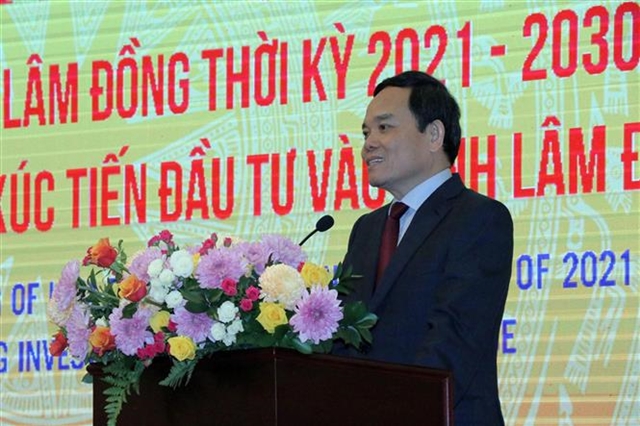Distinctive development predicted by Deputy PM for Lâm Đồng Province
Society – Economy - Ngày đăng : 09:55, 24/06/2024
 |
| Deputy Prime Minister Trần Lưu Quang speaks at the conference of the Lâm Đồng Provincial Planning for the period of 2021-2030, with a vision to 2050. VNA/VNS Photo |
LÂM ĐỒNG — Deputy Prime Minister Trần Lưu Quang said that with the existing potential, along with the upgrade of Liên Khương Airport to an international airport, Lâm Đồng Province can anticipate robust and distinctive development in the future.
He was speaking while chairing the Lâm Đồng Provincial Planning Conference for the period of 2021-2030, with a vision to 2050, and promoting local investment on Sunday.
Deputy PM Quang highlighted that Lâm Đồng has border gates and numerous highways connecting it to other regions, especially the southeast region. The province's successful implementation of high-tech agriculture provided confidence that it would become the standard-bearer and exemplary model for high-tech agriculture.
Vice Chairman of the Lâm Đồng Provincial People’s Committee Võ Ngọc Hiệp said that by 2030, Lâm Đồng aimed to become a comprehensively developed province in Việt Nam and develop Đà Lạt City and its surroundings into a high-quality tourism centre of national and Southeast Asian significance.
Lâm Đồng would accelerate economic growth, focusing on agriculture and forestry as the main pillars, the processing industry as the driving force and tourism as the breakthrough sector. The province aimed to develop a sustainable, modern, high-efficiency, organic agricultural economy, forming large-scale specialised farming areas and becoming a national and international centre for high-tech organic research and production, he said.
Hiệp also stressed that the province would prioritise sustainable development of the bauxite, alumina, aluminium extraction and processing industries, and the processing of agricultural and forestry products. It would invest in modern, comprehensive infrastructure systems to connect regions linking urban and rural areas and develop efficient, sustainable urban spaces.
According to the plan, by 2050, Lâm Đồng aims to meet the standards to become a centrally-governed city that is modern, distinctive, green, smart and worth living in.
Lâm Đồng aims to develop three key sectors, including agriculture-forestry-fisheries, services and industry construction.
Hiệp said the province would focus on becoming a hub for organic agriculture and high-value commodities in the Southeast Asian market. Crop cultivation would prioritise high-economic-value products for export, such as vegetables, flowers, silk, coffee, tea, fruit trees and tissue-cultured plant varieties.
Livestock farming will be developed on an industrial scale, using high-tech, closed-loop systems, according to the plan. Trade will be strengthened through close economic links with the southeast region, HCM City, the south-central coast, the Central Highlands and other key economic regions.
By 2030, Lâm Đồng aims to become attractive top-tier eco-tourism, wellness and sports resorts in Việt Nam and Southeast Asia. Đà Lạt and its surrounding areas will transform into high-quality urban centres, featuring vibrant night economies and achieving international standards.
The industrial sector will establish clusters in priority industries such as mineral processing and food processing. High-tech, large-investment industrial projects will be prioritised, along with expanding and enhancing existing bauxite projects and investing in new alumina extraction projects.
By 2050, Lâm Đồng aspires to become a centrally-governed city, with its urban area encompassing an expanded Đà Lạt City, including the current Đà Lạt, Lạc Dương District, and five communes from Lâm Hà, Đức Trọng and Bảo Lộc City. The suburban area will include three towns of Lâm Hà, Đơn Dương, Di Linh and three newly formed districts of Đam Rông, Bảo Lâm, and Đạ Huoai.
Under this plan, the province will focus on 227 projects, including 36 transportation projects, 11 industrial projects, 34 cultural, sports and tourism projects, 36 healthcare projects, 20 trade and service projects, 62 residential and urban development projects and 12 agricultural development projects. Key projects include the Đankia-Suối Vàng National Tourism Area, the Tân Phú-Bảo Lộc Expressway, the Bảo Lộc-Liên Khương Expressway, the Nha Trang-Liên Khương Expressway, the expansion of Liên Khương Airport, the bauxite mining and alumina processing plant complex, the Đà Lạt High-Tech Agricultural Zone and dry ports in Đức Trọng District and Bảo Lộc City.
At the conference, the Lâm Đồng Provincial People's Committee presented investment registration certificates, investment policy approval decisions and investment memorandums of understanding to several businesses and investors preparing to invest in the province.
On Sunday morning, Deputy PM Quang attended the ceremony announcing the official upgrade of Liên Khương Airport to an international airport, an event organised by the Ministry of Transport and the Lâm Đồng Provincial People's Committee.
Liên Khương Airport is currently classified as a 4D airport according to the regulations of the International Civil Aviation Organisation (ICAO). The airport features a runway that is 3,250 metres long and 45 metres wide.
During the 2021-2030 period, Liên Khương Airport is projected to handle approximately 5 million passengers and 20,000 tonnes of cargo annually. The current runway configuration will remain unchanged.
Looking ahead to 2050, the airport's capacity is expected to increase to 7 million passengers and 30,000 tonnes of cargo per year. Additionally, the existing runway will be extended 350 metres to the west, making it 3,600 metres long and 45 metres wide. The total planned area for the airport will exceed 340 hectares. — VNS
